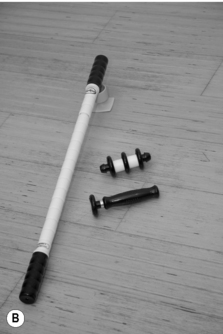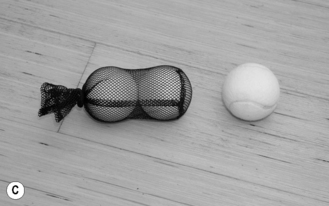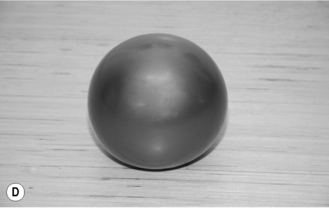15. Self-massage and myofascial release techniques for the athlete
Self-massage techniques are beneficial for the athlete since this modality can be administered whenever the need arises, independent of the presence of a sports massage therapist. Massage in different forms has demonstrated a reduction of the intensity of soreness after workout (Ernst, 1998 and Hilbert, 2003), and it is believed that massage in combination with other modalities can assist in the healing of repetitive strain injuries (Sheon 1997). The various benefits generated from massage can also fall under the category of self-massage, provided it is performed in an effective manner. Although self-massage has some limitations (Cash 1996), the techniques may serve as a good supplement to regular sports massage sessions. Self-massage is beneficially utilized during pre-, post- (Pozenik 2003), and interevent scenarios if no therapist is present, but the techniques also have a place in the remedial phase.
Tools
General self-massage is commonly performed with the hands, but correct usage of specific tools is very useful to enhance the effects, particularly for athletes with a more substantial muscle mass. A firm foam roll (Fig. 15.1A), or a massage device like The Stick (Fig. 15.1B), etc., may successfully increase the massage effects and additionally generate self-myofascial release for the athlete. Tennis or lacrosse balls can generate a similar result, especially when placed stationary (Fig. 15.1C), and a smaller soft exercise ball serves a similar purpose when used over more sensitive areas (Fig. 15.1D).
The following examples offer very basic suggestions for self-massage using the hands, foam rolls, balls, and/or The Stick. The hand massage can additionally, like regular muscle massage, expand to utilize numerous variations on strokes, based on effleurage, compressions, petrissage, frictions, stripping, edging, special frictions, etc., discussed in Chapter 2.
Feet
Self-massage of the plantar aspect of the feet
1. The athlete can use a tennis ball, baseball, lacrosse ball, or a foot wheel (Fig. 15.2), to massage the plantar aspect of the foot. The massage is performed in circles, straight lines, or as compression, and should range from the heel to the plantar aspect of the toes. The pressure should generally increase as the tissue relaxes.
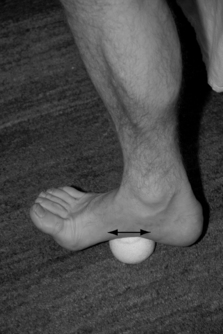 |
| Figure 15.2 |
2. Thumb frictions on the dorsal part of the foot works between the metatarsal bones and the toes (Fig. 15.3).
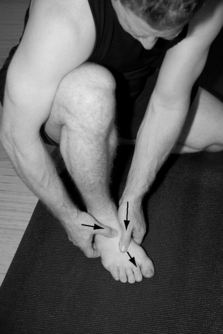 |
| Figure 15.3 |
Lower legs
Self-massage of the anterior lower leg
1. Thumbs. The athlete sits comfortably and relaxes the muscles in the lower leg. Using reinforced thumb stripping, the athlete massages the tibialis anterior muscle, including the muscle belly and fascial structures, in short strokes (Fig. 15.4A).
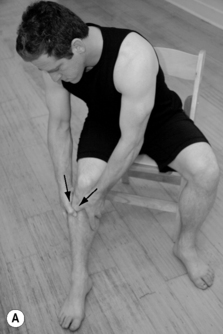 |
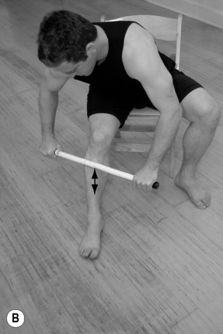 |
| Figure 15.4 |
2. The Stick. The athlete sits in the same position and systematically rolls The Stick along the tibialis anterior and peroneal muscles, with the majority of the pressure in the direction of the heart (Fig. 15.4B).
Self-massage of the posterior lower leg
1. Thumbs. The athlete sits with bent legs. The thumbs edge the lateral and medial aspect of each muscle belly along the muscle’s length (Fig. 15.5A).
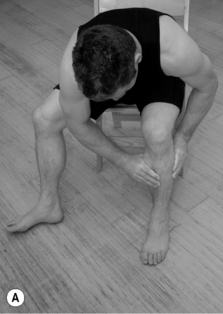 |
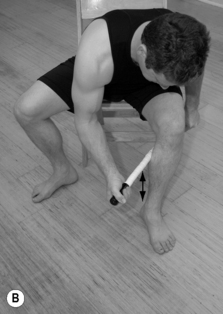 |
| Figure 15.5 |
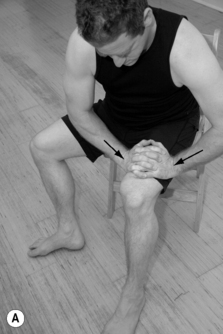 |
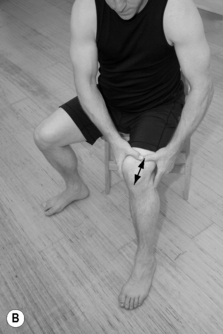 |
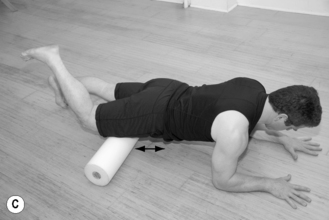 |
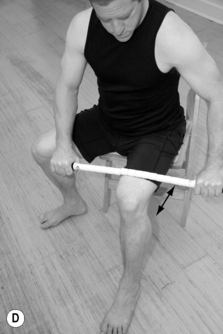 |
| Figure 15.6 |
2. The Stick. The athlete sits in the same position and rolls The Stick along the length of the muscle, with the majority of the pressure in the direction of the heart (Fig. 15.5B).
Thighs
Self-massage of the anterior aspect of the thigh
1. Hands. The athlete sits with the legs relaxed and clasps the hands, performing double palm compressions of the quadriceps femoris muscle along its whole length (Fig. 15.6A).
2. Reinforced thumb cross frictions. This is followed by reinforced thumb cross frictions on tensed and/or fibrotic areas of the muscle (Fig. 15.6B).
3. Foam roll. The athlete lies on the ground with one leg on a foam roll, and slowly moves the body to have the roll massage along the thigh (Fig. 15.6C). To enhance the depth, the athlete initially performs an isometric muscle contraction of the quadriceps femoris muscle for 10s, followed by relaxation and continued foam roll massage of the muscle. The athlete can also increase the amount of flexion in the knee joint to gradually increase the stretch effect during the treatment.
4. The Stick. The athlete either sits on the edge of a seat or stands, using The Stick to slowly massage the quadriceps femoris and adductor muscles along their length, with the majority of the pressure applied on the upward stroke toward the groin. To additionally increase the stretch effect, the leg is gradually flexed at the knee joint for the quadriceps femoris muscle, or abducted for the adductor muscles, to the end point for each stretch as the soft tissue relaxes (Fig. 15.6D).
Self-massage of the posterior aspect of the thigh
1. Fingertips. The athlete sits with the legs bent to access the hamstring muscles. The muscle is edged and stretched with the fingertips, pushing into the mid part of the posterior thigh, stretching the soft tissue first medially, then laterally along the entire length of the muscles (Fig. 15.7A).
< div class='tao-gold-member'>
Only gold members can continue reading. Log In or Register to continue
Stay updated, free articles. Join our Telegram channel

Full access? Get Clinical Tree




